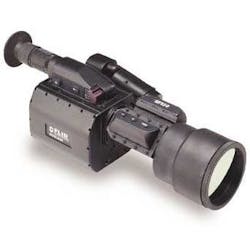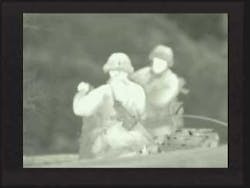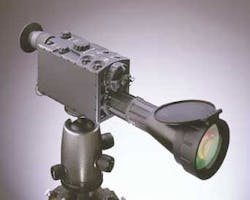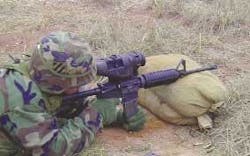Optoelectronic devices such as laser sights, binoculars, and infrared sensors are enabling the transformation of American special operations forces to deploy and execute their missions more quickly and more efficiently than ever before.
The role of the U.S. special operations forces warfighter changed after the terrorist attacks of Sept. 11, 2001. Prior to that time the role of special operations was to support conventional operations, but now special operations forces are the front lines and sometimes the only military force sent in to counter a terrorist attack or perform a pre-emptive strike.
In an address to Congress last year, Thomas W. O’Connell, assistant secretary of defense for special operations and low-intensity conflict said the U.S. Special Operations Command must modernize and transform to continue to gain momentum in the war on terrorism.
PHOTO:The MilCAM Recon, FLIR's long-range infrared imager, zeros in on targets through smoke, dust, battlefield obscurants, and degraded weather conditions with a dual field-of-view 50/250-mm optic.
He added that while special operations forces always were a part of the equation in addressing terrorism, the “posture and role” of those forces today in combating and defeating global terrorism has changed. Special operations forces involve forces such as the U.S. Navy SEALs, the U.S. Army Special Forces - also known as the Green Berets - and U.S. Army Rangers.
“Previously, we were postured to defend against a state projecting force across great distances, and we built extensive capabilities to provide us early warning and tools to deter aggression,” O’Connell told Congress. “But the potential destructiveness of an attack of the type we suffered on 9/11 means that we are no longer afforded an opportunity to determine an ‘appropriate response,’ nor make a clear determination of when decisive action is too little or too late.”
O’Connell pointed out that special operations forces originally were conceived for “supporting or leveraging” larger conventional forces in battle, or for undertaking discrete and limited strategic missions. The new reality of war, he said, has given them a more “prominent, front-line, essential role.”
O’Connell said modernization and transformation efforts included transforming special operations forces’ capabilities to better locate and track individual terrorists across the globe and conduct small, surgical operations with minimal risk to the employed force.
The next generation of technologies for Special Forces must be even more intuitive than they are today, says Glenn Herosian, manager of Integrated Security Systems for FLIR Systems in North Billerica, Mass. In other words, they need to replicate more and more functions of the brain much like the autofocus does in cameras today.
Special Operations personnel will most likely be the first to get this equipment because they are the front lines today. In many ways they are like a testbed for new technologies, says John Hodge, ground systems sales manager for FLIR. They know what they need for missions and how to make the most out of new technology.
Dealing with special operations customers is different from dealing with others, Hodge continues. They want high performance and quick turnarounds like everyone else, but most of the designs are custom. They rarely buy something off-the-shelf because their missions have very specific needs, Hodge says. Products FLIR develops for Special Operations may one day be available off-the-shelf for other applications.
In addition, special operations forces need accurate optical technologies so they can identify targets and shoot targets without being seen in daytime or night, says Hodge, an Army Special Operations veteran. Optical devices include, weapons sights, cameras, binoculars, and night-vision goggles.
Many companies are supplying Special Forces with key optical equipment, including FLIR, Raytheon, Northrop Grumman, DRS Technologies, EoTech, B.E. Meyers, BAE Systems, Rockwell Collins; and others.
FLIR Systems
FLIR’s man-portable 4.5-pound rugged long-range weapon sight, the SnipIR, mounts on top of, and is viewed through, the weapon’s day scope; its long-range performance and thermal sensitivity provides the ability to detect targets out to 1,500 meters. Its cryogenically cooled imager is powered by one “D” cell lithium battery for more than four hours operation. During daylight hours, operators can fuse the visible-light image from the day scope with the SnipIR’s thermal image.
FLIR’s imaging technology enables soldiers to command the night.
The SnipIR combines optics and infrared detector technology with a daylight sight so that users can acquire targets in complete and total darkness. During daylight hours, operators can fuse the visible light image from the day scope with the SnipIR’s thermal image, making it ideal for overcast days or when battlefield smoke is present.
FLIR also offers a rugged handheld imager, the SeeSPOT III, which is for stand-alone operations or with a 1.06-micron laser target designator. Providing four times the thermal sensitivity of uncooled IR viewers, the SS3 delivers detailed long-range thermal imagery in most climatic conditions, day and night, FLIR officials say. SeeSPOT III increases first-hit probability and keeps friendly fire incidents to a minimum by enabling the operator to view images simultaneously from the designator’s laser spot and the target scene.
SeeSPOT III’s long-range, 250-millimeter-focal-length lens, detects man-size targets about 3.5 miles away, and recognizes man-size targets as far away as 1.5 miles. The target’s thermal imagery is viewed on a high-resolution miniature liquid-crystal display through the unit’s eyepiece.
FLIR’s SeeSPOT III can be used in stand-alone operations or with a 1.06-µm laser target designator.
The rugged 5.5-pound MilCAM Recon, FLIR’s long-range infrared imager, zeros in on targets through smoke, dust, battlefield obscurants, and degraded weather conditions with a dual field-of-view 50/250-millimeter optics, and enables users to classify vehicles at ranges as far away as three miles.
Recon offers remote-control capabilities and a tripod mount, and can operate from a computer or laptop via the camera’s digital interface. Convenience and dependability features include an auto level, selectable reticles, a digital interface, a video overlay, and AC or DC power options.
For more information go online at www.flir.com.
Raytheon
Raytheon Co. in McKinney, Texas, continues to provide the U.S. Army with its Thermal Weapon Sights (TWS). The latest Army contract includes TWS production systems, spare equipment, training, and maintenance in support of new and existing systems. The company will produce the units in its Dallas manufacturing facility. The contracting agency is the U.S. Army’s Communication-Electronics Command on behalf of Program Executive Office Soldier at Fort Belvoir, Va.
The Light Thermal Weapon Sight from Raytheon Network Centric Systems features a 2-to-1 electronic zoom, a liquid-crystal display (LCD), and an eyecup activated stand-by mode for power conservation.
The AN/PAS-13 TWS is a family of advanced thermal imaging sensors that improves soldiers’ surveillance and targeting in zero illumination and in obscurants such as fog, smoke, dust, and sandstorms, Raytheon officials say. TWS will equip the following weapons: Light TWS units for M-16s, M-4s and M-136s; Medium TWS for M-249s and M-240s; and Heavy TWS for M-2s, M-16, M-4 and MK-19.
Raytheon has delivered more than 12,500 TWS systems since it received the Thermal Omnibus contract in 1998. With the delivery of all units under contract, the company will have delivered more than 27,000 TWS systems to the U.S. Army, Marine Corps, and Special Operations Forces.
For more information go online at www.raytheon.com.
Northrop Grumman
The AN/PVS-17 Mini Night Sight (MNS) from Northrop Grumman Electro-Optical Systems in Baltimore is designed to meet the specific requirements of the U. S. Naval Surface Warfare Center for a lightweight, compact, high performance system for the Special Operations Peculiar Modification (SOPMOD) program. The MNS uses Northrop Grumman’s latest OMNI V enhanced GEN III image intensifier that will offer performance equal to some 3X and 4X fielded systems, Northrop Grumman officials say. Other Gen II and Gen III tubes are also available.
AN/PVS-17 weighs less than two pounds and is submersible to 66 feet. Mounting on the extended carbine rail has been optimized to enable other systems to be used in conjunction with the sight such as a laser illuminator.
AN/PVS-17 has a three-position OFF/ON/ON knob. The first ON position places the system in a standby mode, and activates with a momentary pushbutton located on the top of the unit. The second ON position is for continuous operation. A remote-control pad activates the sight when the ON switch is in the momentary position. This momentary action enables presetting controls before observation, saves battery life, minimizes the need for shuttered eyecups, and provides a “quick-look” capability. The Red LED Dot projected reticle has five brightness levels controlled by its own selection knob.A neck strap is provided for use when the sight is used as a detached observation device.
For more information go online at www.es.northropgrumman.com/es/eos/index.htm.
DRS Technologies
Officials of the Army Communications-Electronics Command (CECOM) at Fort Monmouth, N.J., awarded DRS Optronics in Melbourne, Fla., a five-year potential $375 million contract to design and build a new family of light, medium, and heavy thermal weapon sights for a wide variety of weapons, including infantry assault rifles.
DRS optoelectronics designers are using advanced microbolometer-based infrared technology for these thermal weapon sights, which will give Army soldiers and armament crews the ability to detect and identify threats at long surveillance and target-acquisition ranges.
The new family of weapon sights will function regardless of light level, weather conditions, or adverse battlefield conditions, DRS officials say. The light weapon sights weigh about 1.6 pounds and will mount onto handheld automatic weapons.
DRS engineers are developing the thermal weapon sights together with experts from the Army’s Team Soldier at Fort Belvoir, Va. DRS will build the sights at the company’s DRS Optronics facilities in Palm Bay and Melbourne, Fla., and at the DRS Infrared Technologies facilities in Dallas.
For more information go online at www.drs.com.
BAE Systems
Engineers at BAE Systems Information and Electronic Warfare Systems in Lexington, Mass., design the SCC500 Series IR Camera Cores. The SCC500 Series SCC500L (160 × 120), SCC500H (320 × 240), and SCC500X (640 × 480) are low-cost IR camera cores aimed at the commercial and military OEM and COTS applications.
The camera cores generate strong image quality over an extended operating temperature range with wide dynamic range (14 bit) and real-time 60-Hz frame rate (30 Hz for the SCC500X).
Unique to the SCC500 Series is a common back-end electronics package and electrical interface providing a solution ideal for OEMs developing a family of systems differentiated by resolution.
The SCC500 Series camera cores also incorporate a flex cable between the front-end card/lens assembly and the back end electronics. This feature provides the OEM with the flexibility to adjust the camera core layout to meet packaging constraints.
For more information go online at www.iesi.na.baesystems.com/business. htm.
EoTech
U.S. soldiers deployed in Iraq and Afghanistan are using a new holographic weapon sight from EoTech Inc. in Ann Arbor, Mich. Soldiers with the 82nd Airborne Division are using the EoTech Holographic Weapon Sight (HWS) 550 on their M-16 and M-4 rifles to improve their fighting capability in close quarters, says John Bailey, technical sales support at EoTech.
The HOLOgraphic Weapon Sight from EoTech enables soldiers to get shots off more quickly and accurately in a close-quarter battle environment.
The optical weapon sight is fast, accurate, and offers substantial peripheral vision, EoTech officials say. The durable sight leaves no muzzle side operator signature, company officials claim. The technology deploys with elite military special operations forces and SWAT teams worldwide, Bailey says.
EoTech also received notification from Crane (the contracting group) at the Naval Warfare Surface Center. EoTech won a maximum $16.7 million contract for 66,666 enhanced combat optical sights (ECOS-C) and associated data, DOD officials say. The ECOS-C capability provides for a lightweight, waterproof optical sighting device(s) capable of providing target acquisition and aiming for close quarter battle as well as out to 600 meters.
Today’s U.S. Navy F-14 Tomcat jet fighters use holographic head-up display (HUD) technology to meet the requirement for super-fast, accurate target acquisition, yet this is the first application of holographic technology to small arms, Bailey claims.
EoTech officials demonstrated the sight to Military & Aerospace Electronics at the Association of the U.S. Army show last fall. During the demonstration two U.S. Army Rangers approached and tried it out, and when asked what is the biggest benefit of the HWS, one replied, “in close quarters, we would be able to get the shots off quickly and with more accuracy.”
“As for the sights, well . . . the best way to put it is . . . they are like cheating,” says a U.S. military special operations operator in Afghanistan. “Really, those things are the best tools that I have. It is so fast and easy to acquire that it’s idiot proof. You don’t loose the reticle in the bright light and the dot is super easy to acquire.”
The unique qualities of EoTech’s device revolve around its HUD; all the information necessary to reconstruct the reticle image is recorded everywhere in the HUD window, Bailey says. Shooters use the reticle - or the red circle - to aim when looking through the sight. A reticle is grid or pattern placed in the eyepiece of an optical instrument to establish scale or position.
If mud, snow, or water blocks the window, the HWS remains operational and maintains point of aim/impact. Even in such extreme cases where the laminated window is shattered, the HWS functions as long as the operator can see through any portion of the window - the entire reticle pattern is visible on target.
Its range is solid at 200 meters and has been demonstrated at 300 meters, Bailey says. U.S. Marines qualify their marksmen at distances as far away from their targets as 500 meters, but EoTech is sticking to 200 meters as the standard range, he adds.
Holography can create virtually any image as a reticle pattern, in either two or three dimensions. Given sufficient volume, the HWS’s reticle patterns can support a host of applications in small arms and medium-size weapons, as well as individual launching platforms.
The HWS, which has two laser diodes that project the reticle image onto the glass, is waterproof, fogproof, shockproof, and withstands extreme temperature variations. It can withstand a 10-foot drop with no degradation to the weapon optic, company officials say.
An on-board microprocessor provides automatic battery check indicator, up/down brightness scrolling, and programmable auto shut down features. All electronics are in a shock-absorbing resin compound.
For more information on the HWS 550 visit www.eotech-inc.com.
B.E. Meyers
U.S. Army Rangers at Fort Benning, Ga., continue to obtain a high percentage of first-round hits with the MK Ranger high-angle trajectory sight and mount from B.E. Meyers in Redmond, Wash., says Brad Meyers, company president.
The MK Ranger is a high-angle trajectory mount for grenade launchers and machine guns, B.E. Meyers officials say. This mount adapts either to the MK-64 or the MK-93 cradles and enables the MK-19 to aim at targets near the maximum range of the weapon - even in total darkness - with a 40-millimeter laser mandrel inserted in the bore.
“It can launch multiple high-explosive rounds accurately out to targets farther than 2,000 meters,” as long as there is sufficient light to see the target, Meyers says. Targets are more difficult to hit at night because of the high-angle trajectory and lack of an efficient night-vision sighting device.
However, the MK Ranger enables instant target acquisition, even in total darkness, making the MK-19 nearly as accurate at night as during the day, company officials claim. One laser illuminates the target area and one pinpoints the target with a red dot, Meyers says. Thousands are used by the U.S. military, he says.
The device originated from a request from the Dismounted Battle Lab at Fort Benning. “We initiated development of a high angle multi-purpose sighting system that would adapt to existing mount cradles such as the MK-64 and MK-93 and ensure first round hits” in darkness using standard PVS-7B night vision goggles in the dead of night, Meyer says.
Each MK Ranger high-angle trajectory mount is available with two bore-sighting laser systems, B.E. Meyers officials say. These lasers are precentered for accuracy and include a mandrel that simply slips down the bore of the prospective weapon. Each mandrel also includes an all-weather targeting cloth for each laser.
B.E. Meyers engineers also released the Durable Illumination Aiming Laser - DIAL-100 - that can be used with the MK Ranger. The DIAL-100 provides infrared night aiming and a higher-energy daytime visible aiming laser, Meyers says. The infrared and illumination lasers aim and align together through the same lens. The device also weighs less than 10 ounces with the battery - one AA or one CR123 lithium battery.
“When the DIAL-100 is combined with our Flash Terminator and Bore Sighter it eliminates the need for tracer rounds,” Meyers says.
For more information on the MK Ranger visit www.bemeyers.com.Raytheon provides sensors for Army special operations helicopter
Officials at Raytheon Co. in El Segundo, Calif., are providing the U.S. Army’s Special Operations Command with 128 electro-optic (EO) sensors systems.
The ZSQ-1(V) sensor systems will provide improved navigation, surveillance, and targeting capabilities, as well as improve mission performance and situational awareness onboard MH-47, MH-60, MH-60 DAP, and AH- 6 helicopters during day or night operations, Raytheon officials say.
Under the contract, Raytheon Space and Airborne Systems (SAS) will design, build, and deliver two variants of the ZSQ-1(V) EO sensor suite for assault and attack operations. The suites will contain laser range finders or laser spot trackers/designators, laser pointers, forward-looking infrared (FLIR) sensors, image-intensified television (I2TV), and processing and control electronics.
Follow-on orders under the contract could bring the total number of sensor systems produced to approximately 260.
Contract work will be performed in El Segundo, Calif., and other Raytheon facilities in the United States and Canada. All deliveries are expected to be complete by 2010.
Northrop Grumman delivers first fused Multispectral Weapon Sight to U.S. Army
Northrop Grumman Corp. in Garland, Texas, delivered its first Fused Multispectral Weapon Sight (FMWS) to the U.S. Army. The sight will improve foot soldiers’ survivability and lethality, enhancing their ability to “control the night,” company officials claim
The company’s Electro-Optical Systems (EOS) unit has integrated advanced image sensors, electronics, and optics to produce the digitally image-fused weapon/observation sight. The FMWS combines the capabilities of an image intensifier with those of an infrared detector.
“The sight yielded very impressive results, producing clear images on both image-intensifier and infrared channels with surprising flesh tones,” says Jack Lillie, the Army’s FMWS program manager, following a demonstration. “It will provide the U.S. warfighter with a great advantage over the enemy in situational awareness, based on the best of both imaging worlds.”
The FMWS will augment conventional night-vision capability by adding infrared detection of “hot” targets such as recently driven vehicles or recently fired weapons, imaging and detection of near-infrared lasers, imaging through glass and through battlefield obscurants, depth-of-field enhancement, and real-world visual cues, Northrop Grumman officials say.
The Army’s upcoming field trials will garner feedback from the infantry as well as from participants representing the U.S. Marine Corps and Special Operations Command. The initial FMWS trial unit, first unveiled at the Marine Corps’ Industry Day in mid-July, was also demonstrated at the Modern Day Marine Exposition and at the Army’s Infantry Conference, both of which took place last month.
In addition to producing image-intensifier tubes and night-vision systems for both ground and airborne applications, Northrop Grumman offers a full array of precision optics, including components, coatings, optomechanical assemblies and optical systems.
The EOS unit is part of Northrop Grumman’s Baltimore-based Electronic Systems sector.
BAE Systems receives contract for Stryker thermal imaging module
Officials at BAE Systems in Nashua, N.H., will supply the upgraded Thermal Imaging Module (TIM1500) for the Remote Weapon Station (RWS) on the U.S. Army’s Tank Automotive and Armaments Command (TACOM) Stryker vehicle to Kongsberg Protech of Norway. The contract is estimated at $28 million.
The Stryker is an eight-wheeled armored vehicle, which provides infantry protection in open terrain and quick transport to critical battlefield positions. The TIM program will provide Stryker with an advanced, uncooled thermal imaging camera that identifies targets deep in the battlefield in all weather and obscurant conditions.
Developed and produced at BAE Systems infrared imaging facility in Lexington, Mass., the TIM uses state-of-the-art MicroIR microbolometer-based technology. This thermal engine technology is being developed by Program Executive Office (PEO) Soldier for the Thermal Weapon Sight (TWS) program. The Stryker TIM and the Heavy TWS will share this common thermal engine, which also forms the basis for cameras serving the homeland security and public safety business segments, BAE Systems officials say.
The base contract will fund the development and qualification of the TIM1500.
The Lexington facility is part of BAE Systems Information & Electronic Warfare Systems headquartered in Nashua, N.H. Kongsberg is the RWS supplier to TACOM prime contractor, General Dynamics Land Systems, California Technology Center in Goleta, Calif.
United Kingdom buys more Javelin anti-tank missiles
The United Kingdom’s Ministry of Defense placed a follow-on order, valued at approximately $180 million, for the Raytheon-Lockheed Martin Javelin weapon system. This purchase of Javelin will provide a medium-range anti-tank missile for the British Army’s Armored Ground Component (AGC) requirement.
The selection of Javelin for AGC follows a competitive win by the Javelin Joint Venture and its U.K. partners for the United Kingdom Light Forces Anti-tank Guided Weapon program in 2003. This follow-on order increases the number of rounds and command launch units that will be procured through a hybrid foreign military sale/direct commercial sale.
“Continued Javelin procurement will provide the U.K. forces with one of the most precise and lethal weapons on the battlefield for many years in the future,” says Col. Lloyd E. McDaniels, the U.S. Army’s project manager at U.S. Army Close Combat Weapon Systems.
“Also, the Javelin’s integrated day and thermal night sights provide the soldier with the ability to perform surveillance missions and increases situational awareness to the commander and Javelin gunners and ensures both operational and logistic interoperability with U.S. Army, Marine, and Special Operation Forces.”
Minister for Defense Procurement Lord Bach says, “Javelin is already in service with the U.S. Army and has proved its worth in recent operations in Iraq. It is maneuverable enough to move quickly around the battlefield but also has enough power to take out the most heavily protected tanks and armored vehicles.
“We agreed a contract to provide the weapon to 16 Air Assault Brigades, three Commando Brigades and the Mechanized Infantry last year and have now agreed an additional purchase for other infantry and reconnaissance units, ensuring they are equipped with the very best weaponry available.”
With this award, Javelin becomes the United Kingdom’s premier anti-armor/assault weapon and will be fielded with light rapid reaction forces, mechanized forces and now the armored forces. Javelin will provide the latest man-portable, anti-tank weapon capability that can be used day or night.
With a range as far as 2,500 meters, using long-wave imaging infrared technology, it will allow for deployment by a single soldier and can be fired from within a confined space. The Light Forces component of the Javelin program will enter service in 2005. The AGC Javelin program will enter service in 2007.
Javelin is in service with the U.S. Army and Marine Corps and has been used extensively on operations including Operation Iraqi Freedom. Along with the U.K. selection of Javelin, other nations that have already procured Javelin include Australia and New Zealand. Javelin is also on order for the armed forces of several other countries and is being evaluated for integration onto ground and naval platforms.
The Javelin JV is working on a number of technology spirals with both the U.S. and U.K. in support of future requirements including extended range. Future applications such as U.S. Future Combat Systems and the U.K. Future Rapid Effects Systems-Guided Weapon are considered potential future technology insertions.





